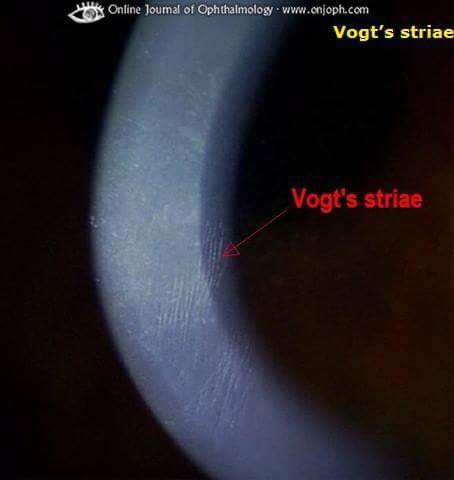Lines in Ophthalmology
1.Arlt’s Line
= conjunctival scar in sulcus subtarsalis in Trachoma.
Horizontal line of conjunctival scarring in sulcus subtarsalis of superior palpebral conjunctiva.
2.Ehrlich-Turck Line
= linear deposition of KPs in uveitis
3.Ferry’s Line
= corneal epithelial iron line at the edge of filtering blebs.
4.Hudson-Stahil Line
Iron deposition line in the corneal epithelium, which commonly seen in the junction between middle and lower third cornea (upper border of normal tear layer strip).
Often seen in the elderly.
Causes no symptoms or clinical significance.
5.Khodadoust Line
= corneal graft endothelial rejection line composed of inflammatory cells.
Classic endothelial rejection presents with an endothelial rejection line (Khodadoust line) that usually begins at a vascularized portion of the peripheral graft-host junction and progresses, if untreated, across the endothelial surface over several days. The rejection line consists of mononuclear white cells that damage endothelial cells as the line sweeps across the endothelium.
6.Paton’s Line
= Circumferential retinal folds due to optic nerve edema.
7.Sampaoelesi line
= Increased pigmentation anterior to Schwalbe’s line in pseudoexfoliation syndrome.
Occurs in
- pseudoexfoliation syndrome
- pigment dispersion syndrome
- trauma
- iris melanoma
8.Zentmeyer line (Scheie’s Line):
Pigment on the equatorial surface of the lens and posterior capsule in pigment dispersion syndrome.
"Scheie's line" is considered to be pathognomonic for pigment dispersion syndrome.
9.Schwalbe’s Line
= Angle structure representing peripheral edge of Descemets membrane.
10.Stockers Line
= Corneal epithelial iron line at the edge of Pterygium
11.White lines of Vogt
= Sheathed or sclerosed vessels seen in Lattice degeneration
12.Fingerprint lines:
The map-dot fingerprint dystrophy
13.LASIK Iron Line:
After LASIK for myopia, the central corneal curvature is flatter than before surgery. The tear film distribution is therefore altered, allowing some pooling centrally. This pooling can cause iron deposition in the central epithelium. A similar effect can be seen after steeping of the cornea from treatment of hyperopia. In the case of hyperopia, a pseudo-Fleischer’s ring iron deposition can be seen. These iron lines do not affect vision.
14.Vogt’s striae
it occur centrally in a patient with keratoconus. By applying digital pressure on the eye while looking through the slit lamp, these striae in the deep cornea, mostly Descemet’s membrane, disappear, which is charac teristic of keratoconus.
15.The Descemet’s breaks or Haab’s striae
The Descemet’s breaks or Haab’s striae from birth trauma tend to be vertical, while the Descemet’s tears associated with congenital glaucoma tend to be horizontal or curvilinear.















No comments:
Post a Comment